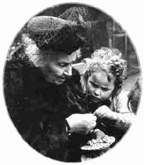About Maria Montessori

Dr. Maria Montessori was the first woman physician
to graduate from the University of Rome, Italy. In 1907 she opened
a care center for the children of desperately poor families in the San
Lorenzo slums of Rome. In her “Children’s House” Dr.
Montessori observed that young children learn best in a nurturing
environment filled with developmentally appropriate materials that provide
experiences contributing to the growth of self-motivated, independent
learners. She carried her message of respect, purposeful activity,
freedom to learn within limits, and the child’s capacity to learn and
absorb from his/her environment to North America in 1912. Her method
was initially well received, but interest waned until the mid-1950’s
when the post-war generation focused attention once
again upon the importance of early learning experiences.
Dr. Montessori believed that the mind and the hand are
intimately connected. She structured an environment in which young
children learn through observation and repeated practice with
manipulative objects. Dr. Montessori believed in autonomy in the
learning process. Each individual is unique and must be given freedom
to choose the material for self-construction. Under the guidance of
the Montessori teacher, the development of responsible choice maintains
order in the environment and becomes a mechanism of personal growth.
From ages 6 through 12, the continued use of Montessori manipulatives
facilitates more advanced abstract and critical thinking that carries over
into the middle school years. Today Dr. Montessori’s methods
continue to recognize and emphasize the importance of early education in the
formation of character and society.

